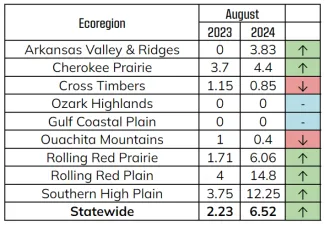August 2024 Quail Roadside Survey
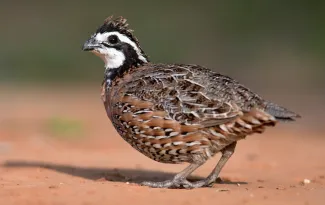
Habitat, Weather Keys to 2024 Bobwhite Boom
El Nino Helps Drive Quail Numbers to 8-year High
By Tell Judkins, Upland Game Biologist
The August 2024 roadside quail survey shows the statewide quail index up substantially over 2023, climbing from 2.23 to 6.52 quail per route surveyed. This result is 28.8% above the 35-year statewide average of 5.06 quail per route (Table 1 and Figure 2), and 92.3% above the 10-year average of 3.39 quail per route.
The Oklahoma Department of Wildlife Conservation has conducted annual roadside surveys in August and October since 1990 to create an index of annual population fluctuations. The number of quail observed is reported to provide an index of quail abundance and indicates reproductive success. Currently, ODWC employees survey 81 routes in 75 of Oklahoma’s 77 counties. Oklahoma and Tulsa counties, almost exclusively urban areas, are excluded from the survey.
The survey data is presented using two methods: one is based on geographic regions (Figure 1), and the other is based on ecoregions (Figure 11). Considering the results from both methods can provide a more precise view of on-the-ground conditions in each county and can give hunters a better idea of what they could find in areas they intend to hunt.
Age structure of observed quail shows 54.2% full grown, 38.3% three-fourths grown, 6.8% half grown, and 0.8% one-fourth grown birds. This age structure indicates successful early broods with additional nesting throughout the summer. Last fall, the latest known hatch was documented from ODWC’s wing-box program: A harvested quail hatched out mid-September in the Northcentral Region. Two other birds appeared to be from later hatches in far-western parts of the state, but the wings were badly damaged which made aging difficult. Additionally, ODWC biologists have received several reports of broods of varying ages throughout summer.
All regions of the state except the Southeast improved from the 2023 survey. All regions, other than the Southeast Region, are currently above their historic 35-year average and 10-year average. (Figures 3-8).
The past winter was fairly mild for Oklahoma, with only a few major systems that brought bitter cold air. After three consecutive years of La Nina (warmer/dryer) weather patterns, last spring saw a transition to El Nino (cooler/wetter), which generally can lead to improved habitat conditions and the potential for better quail numbers. Fortunately, that El Nino pattern persisted until April. By May, the pattern transitioned into an “ENSO-Neutral” state, or within a half-degree of average Pacific Ocean index temperatures.
Drought is now affecting about 75% of Oklahoma, with less than 20% in the severe or extreme drought categories. Rainfall throughout the growing season has been somewhat regular across much of the state, coming at times in monsoon-like systems dumping several inches locally at a time. Precipitation in the spring had on-the-ground conditions looking pretty good; by mid-March 55% of the state was drought-free. Summer heat and a lack of rain over the last 60 or so days have allowed drought to steadily take hold again, especially in the Southwest Region. Figures 9-10 show current drought and rainfall conditions across the state.
Over the last 180 days, most of Oklahoma has seen below-normal rainfall. Some areas in the Southwest have had less than 20% of the normal rainfall over the last 60 days. Even with the higher number of quail sightings, dense vegetation along roadsides in some areas likely contribute to fewer observations.
Roadside survey numbers can also be viewed on an ecoregion basis. Figure 11 shows the nine major ecoregions of Oklahoma, while Table 2 gives a comparison of 2023 and 2024 survey results by ecoregion.
One pair of scaled quail was observed during the 2024 August survey. There are only a few routes in Oklahoma with the opportunity to observe scaled quail. Therefore, this is not a prediction of scaled quail abundance, strictly an observation. ODWC has received several reports of scaled quail broods in the Oklahoma Panhandle this year.
Over the past 35 years, August Roadside Surveys have shown that they are not always the most reliable when it comes to forecasting the upcoming season. Stay tuned for October Roadside Survey results and a 2024 Quail Season Outlook, which will provide a better indication of what the upcoming quail season could have in store
Oklahoma’s quail season will open Nov. 9 and close statewide Feb. 15, 2025. Many public areas in western Oklahoma will be closed Feb. 1-15, 2025, for nonresident quail hunters. Bag limit remains 10 quail daily. For more information, consult the Oklahoma Fishing and Hunting Regulations online at wildlifedepartment.com/hunting/regs, on the Go Outdoors Oklahoma mobile app, or in print wherever hunting and fishing licenses are sold.
Figure 1. Oklahoma Roadside Survey Regions
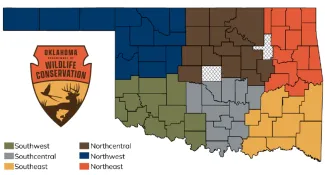
Table 1. Bobwhite Quail Observations/20-mile Route by Geographic Region in Oklahoma
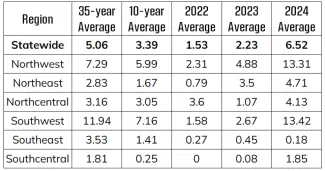
Figure 2. Long-term Average of Bobwhite Observations in Oklahoma
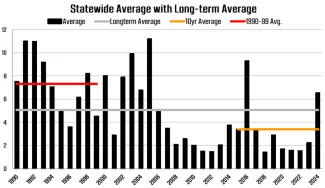
Figure 3. Long-term Average of Bobwhite Observations in Northwest Oklahoma
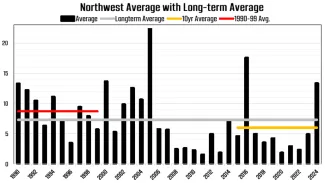
Figure 4. Long-term Average of Bobwhite Observations in Northeast Oklahoma
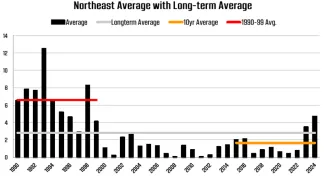
Figure 5. Long-term Average of Bobwhite Observations in Northcentral Oklahoma
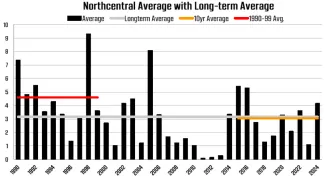
Figure 6. Long-term Average of Bobwhite Observations in Southwest Oklahoma
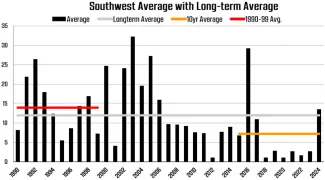
Figure 7. Long-term Average of Bobwhite Observations in Southeast Oklahoma
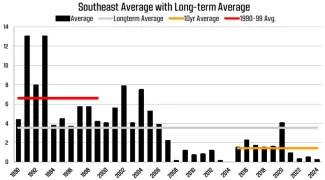
Figure 8. Long-term Average of Bobwhite Observations in Southcentral Oklahoma
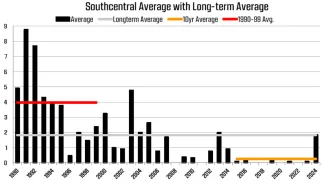
Figure 9. Drought Comparison from March 12 to Aug. 29, 2024 (Source: droughtmonitor.unl.edu)

Figure 10. Departure from Normal Rainfall in Inches: March 8 to Sept. 3, 2024 (Source: mesonet.org)
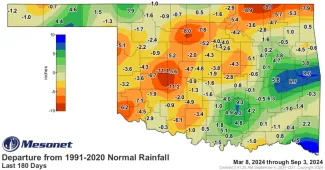
Figure 11. Ecoregions of Oklahoma
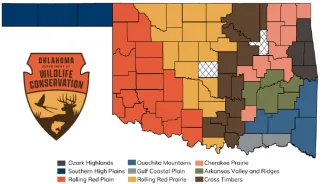
Table 2. Bobwhite Numbers/20-mile Route in Geographic Ecoregions of Oklahoma
